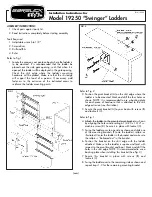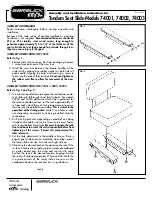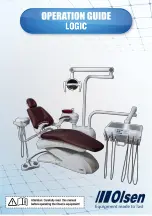
A S 5 0 0 0 S E R V I C E M A N U A L
8
Chapter 6 – Alarms and Alerts
The
A
rctic
S
un
®
Temperature Management System safety system
continually monitors the state of the device and the patient, and
issues alarms or alerts to notify the user of conditions that may
interfere with patient safety or system performance.
There are two types of conditions:
Alarms
and
Alerts
.
An Alarm notifies the user that a condition that may potentially
pose an unsafe situation with respect to the patient or the device.
An Alarm is a High Priority condition that requires immediate
operator response.
An Alert informs the user about patient and device status without
interrupting the procedure. An Alert is a Medium Priority condition
that requires prompt operator response.
Alarms
An Alarm is denoted by an audio signal that repeats every
10 seconds until the Alarm is cleared. The Alarm screen will appear
that displays the alarm number, alarm title, a description of the
problem or conditions that triggered the alarm, and solutions and
instructions for troubleshooting and resolving the alarm condition.
If certain Alarm conditions are not acknowledged by the operator
within 2 minutes, a Reminder tone will sound. All Alarm settings are
maintained in the event of a power interruption.
Fig. 6-1 Alarm screen
Main Safety Alarms
While there are multiple alarms and safety features in the
A
rctic
S
un
®
Temperature Management System, there are five main safety
alarms that will place the device into Stop mode until the condition
is addressed.
Alarm
Specification
High Patient Temperature 39.5 °C (103.1 °F)
Low Patient Temperature 31.0 °C (87.8 °F)
High Water Temperature 42.5 °C / 44 °C (108.5 °F / 111.2 °F)
Low Water Temperature 3.0 °C / 3.5 °C (37.4 °F / 38.3 °F)
System Self-Test Failure At device power ON
Each time the
A
rctic
S
un
®
Temperature Management System is
powered On, a system self test for the independent safety alarm is
automatically run. This test simulates a “water high temperature”
fault situation on both the primary and secondary water temperature
sensors. Both the primary and secondary safety systems must
respond to the fault and be verified by the opposing safety system.
If either safety systems do not respond appropriately either an
alarm 80 or 81 will be issued. Contact Customer Support.
Non-Recoverable Alarms
If an Alarm condition occurs that prevents proper use of the device
or proper patient treatment (such as the five main safety alarms
discussed above), the system is placed into Stop mode and will not
allow therapy to continue. This type of Alarm is known as Non-
Recoverable. If this situation occurs, cycle the device power (turn
device Off then On). If the alarm recurs contact Customer Support.
Recoverable Alarms
Other Alarms that temporarily Stop the device until the user
is able to correct the cause and clear the Alarm are classified
as Recoverable. If the condition that initiated the alarm is not
addressed and problem persists, the Alarm will recur.
If a Recoverable Alarm occurs:
1) When an alarm is issued the device is placed into
Stop
mode.
2) Read the displayed instructions.
3) Note the
Alarm
number.
4) Press the
Close
button to clear the alarm.
5) Follow the instructions to correct the alarm condition. Perform
the actions in the order listed until the alarm condition is
resolved.
6) Once you have cleared the alarm, press the Start button in the
therapy window to restart therapy. You will hear a tone and a
voice stating “Therapy Started”. Additionally, the active therapy
window and the
A
rctic
S
un
®
Temperature Management System
icon will blink.
7) If the condition does not resolve, contact Customer Support.
Alerts
Alerts are denoted by an audio signal that repeats every 25
seconds. The Alert screen will appear that displays the alert
number, alert title, a description of the problem that triggered
the alert, and solutions and instructions for troubleshooting and
resolving the alert condition.
Fig. 6-2 Alert screen
If an Alert occurs:
1) Read the displayed instructions.
2) Note the Alert number.
3) Press the
Close
button to clear the alert.
4) Follow the instructions to correct the alert condition. Perform the
actions in the order listed until the alarm condition is resolved. If
the condition does not resolve, contact Customer Support.
5) Refer to the
A
rctic
S
un
®
Temperature Management System Help
screens for additional information regarding alarms and alerts.











































